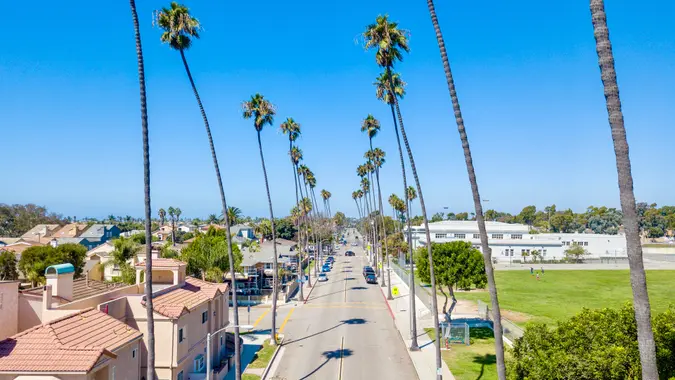Here’s What Rent Gen X Should Expect To Pay in These 6 North Carolina Cities

Commitment to Our Readers
GOBankingRates' editorial team is committed to bringing you unbiased reviews and information. We use data-driven methodologies to evaluate financial products and services - our reviews and ratings are not influenced by advertisers. You can read more about our editorial guidelines and our products and services review methodology.

20 Years
Helping You Live Richer

Reviewed
by Experts

Trusted by
Millions of Readers
If you’re a member of Generation X eyeing a move to North Carolina, what living costs should you expect? How much does rent cost these days in the Tar Heel State’s largest cities?
Average monthly rents in six popular North Carolina cities come in between $1,100 and $1,400, based on data compiled in a recent GOBankingRates study. That’s relatively inexpensive compared to many other states, and it’s part of the reason North Carolina — which has a population with about 30% Gen Xers — has seen such a huge influx of new residents in recent years.
Around 340,000 people moved to the Tar Heel State in 2023, based on figures from the U.S. Census. Only Texas, Florida and California had higher totals.
Generation X generally includes those born between 1965 and 1980. As more members of this group close in on retirement, North Carolina lures them with a reasonable cost of living, vibrant cities, mountains, beaches and some very, very good barbecue. There are possible cons as well, including the state’s vulnerability to extreme weather.
To provide insights into the cost of living in the Tar Heel State, GOBankingRates analyzed data for six cities: Charlotte, Durham, Fayetteville, Greensboro, Raleigh and Winston-Salem. In addition to average monthly rent costs, our list includes total population, livability scores and more. Data was sourced from the U.S. Census American Community Survey, Sperling’s BestPlaces, ApartmentList, the Zillow Home Value Index, AreaVibes and the Bureau of Labor Statistics.
Charlotte
- Total population: 875,045
- Percentage of population age 65+: 10.7%
- Livability score: 80
- Total cost of living (annual): $40,970
- Average monthly rent (overall): $1,448
- Average monthly rent (1 bedroom): $1,317
- Average monthly rent (2 bedroom): $1,436
Charlotte is North Carolina’s largest city and one of the fastest-growing cities in the United States. It boasts multiple professional sports teams, the NASCAR Hall of Fame, the Carowinds Amusement Park and numerous other attractions.
Durham
- Total population: 284,094
- Percentage of population age 65+: 12.7%
- Livability score: 82
- Total cost of living (annual): $39,277
- Average monthly rent (overall): $1,366
- Average monthly rent (1 bedroom): $1,200
- Average monthly rent (2 bedroom): $1,397
Part of the Research Triangle, historic Durham is home to Duke University and North Carolina Central University. It also boasts a strong music scene, the Nasher Museum of Art and multiple festivals throughout the year.
Fayetteville
- Total population: 208,697
- Percentage of population age 65+: 12.6%
- Livability score: 73
- Total cost of living (annual): $36,610
- Average monthly rent (overall): $1,140
- Average monthly rent (1 bedroom): $903
- Average monthly rent (2 bedroom): $1,049
You’ll find Fayetteville in the state’s southeastern region, about 130 miles east of Charlotte. The U.S. Army’s Fort Liberty is located here and is Fayetteville’s largest employer.
Greensboro
- Total population: 297,202
- Percentage of population age 65+: 13.6%
- Livability score: 83
- Total cost of living (annual): $35,175
- Average monthly rent (overall): $1,131
- Average monthly rent (1 bedroom): $999
- Average monthly rent (2 bedroom): $1,113
Located about an hour and 45 minutes northeast of Charlotte by car, Greensboro is North Carolina’s third-largest city. It combines a strong livability score with affordability, including one-bedroom apartments available for less than $1,000 a month.
Raleigh
- Total population: 465,517
- Percentage of population age 65+: 11.4%
- Livability score: 84
- Total cost of living (annual): $40,207
- Average monthly rent (overall): $1,429
- Average monthly rent (1 bedroom): $1,259
- Average monthly rent (2 bedroom): $1,436
Raleigh’s livability score of 84 is at the top of our list. It’s the state capital, the largest city in the Research Triangle region and the home of North Carolina State University. It also boasts more than a dozen museums and the National Hockey League’s Carolina Hurricanes.
Winston-Salem
- Total population: 249,571
- Percentage of population age 65+: 14.6%
- Livability score: 63
- Total cost of living (annual): $35,118
- Average monthly rent (overall): $1,109
- Average monthly rent (1 bedroom): $906
- Average monthly rent (2 bedroom): $1,075
Home to Wake Forest University, Winston-Salem is sometimes called the “Twin City.” It is located about 90 minutes northeast of Charlotte and about a half-hour west of Greensboro.
Methodology: For this study, GOBankingRates analyzed the average rental costs for major U.S. cities and the cost of living in those cities. GBR first sourced the 100 most populated cities from the U.S. Census American Community Survey. Additional information gathered for each city included total population, total households, population ages 65 and over and household median income. Cost-of-living indexes were sourced from Sperling’s BestPlaces. The average overall rental cost, one-bedroom rental cost, and 2-bedroom rental cost were sourced from ApartmentList. The average cost of a condo or co-op was sourced from the Zillow Home Value Index. The livability index was sourced from AreaVibes. GBR used the cost-of-living indexes and the national average expenditure costs for all residents (sourced from the Bureau of Labor Statistics Consumer Expenditure Survey). Using the average condo/co-op value, assuming a 10% downpayment, and using the national average 30-year fixed mortgage rate, the average mortgage was calculated. Using the overall rental cost and expenditure costs, the total cost of living for each city was calculated. All data is up to date as of Sept. 13, 2024.
 Written by
Written by  Edited by
Edited by 

























